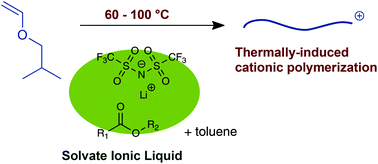当前位置:
X-MOL 学术
›
Polym. Chem.
›
论文详情
Our official English website, www.x-mol.net, welcomes your
feedback! (Note: you will need to create a separate account there.)
Thermally induced cationic polymerization of isobutyl vinyl ether in toluene in the presence of solvate ionic liquid†
Polymer Chemistry ( IF 4.1 ) Pub Date : 2018-03-05 00:00:00 , DOI: 10.1039/c8py00164b Tomohiro Hirano 1, 2, 3, 4 , Ryotaro Kizu 1, 2, 3, 4 , Junpei Hashimoto 1, 2, 3, 4 , Nenji Munekane 1, 2, 3, 4 , Yohei Miwa 4, 5, 6, 7, 8 , Miyuki Oshimura 1, 2, 3, 4 , Koichi Ute 1, 2, 3, 4
Polymer Chemistry ( IF 4.1 ) Pub Date : 2018-03-05 00:00:00 , DOI: 10.1039/c8py00164b Tomohiro Hirano 1, 2, 3, 4 , Ryotaro Kizu 1, 2, 3, 4 , Junpei Hashimoto 1, 2, 3, 4 , Nenji Munekane 1, 2, 3, 4 , Yohei Miwa 4, 5, 6, 7, 8 , Miyuki Oshimura 1, 2, 3, 4 , Koichi Ute 1, 2, 3, 4
Affiliation

|
Radical polymerization of isobutyl vinyl ether (IBVE) was attempted with the aid of the interaction between the corresponding propagating radical and lithium cation (Li+). LiN(SO2CF3)2 (LiNTf2) and ester compounds, such as methyl methacrylate (MMA) and vinyl acetate (VAc), were added as a Li+ source and dissolving agent for LiNTf2, respectively. Homopolymers of cationically polymerizable IBVE were obtained despite the presence of radically polymerizable monomers such as MMA and VAc. Contrary to our expectation, the polymerization proceeded via not a radical mechanism but a cationic mechanism. However, this cationic polymerization was found to be unusual. In particular, the polymer yield increased with the polymerization temperature; successful polymerization was observed at 100 °C, whereas no polymerization occurred at lower temperatures such as at 0 °C. The behavior of the present system was therefore defined as “thermally induced cationic polymerization”. The mechanism of thermally induced cationic polymerization is still not clear, but it is assumed that the propagating cation is markedly stabilized through its interaction with the solvate ionic liquid formed between LiNTf2 and the Lewis base.
中文翻译:

溶剂化物离子液体存在下,异丁基乙烯基醚在甲苯中的热诱导阳离子聚合†
借助于相应的繁殖基团和锂阳离子(Li +)之间的相互作用,尝试进行异丁基乙烯基醚(IBVE)的自由基聚合。分别添加LiN(SO 2 CF 3)2(LiNTf 2)和酯化合物,例如甲基丙烯酸甲酯(MMA)和乙酸乙烯酯(VAc)作为Li +源和LiNTf 2的溶解剂。尽管存在可自由基聚合的单体如MMA和VAC,但仍获得了可阳离子聚合的IBVE的均聚物。与我们的预期相反,聚合通过不是自由基机理,而是阳离子机理。然而,发现这种阳离子聚合是不寻常的。特别地,聚合物产率随聚合温度增加;在100°C时观察到成功的聚合反应,而在较低温度(例如0°C)下没有发生聚合反应。因此,将本系统的行为定义为“热诱导阳离子聚合”。热诱导阳离子聚合的机理仍不清楚,但是可以认为,通过与在LiNTf 2和Lewis碱之间形成的溶剂化物离子液体的相互作用,正在传播的阳离子得到了显着的稳定。
更新日期:2018-03-05
中文翻译:

溶剂化物离子液体存在下,异丁基乙烯基醚在甲苯中的热诱导阳离子聚合†
借助于相应的繁殖基团和锂阳离子(Li +)之间的相互作用,尝试进行异丁基乙烯基醚(IBVE)的自由基聚合。分别添加LiN(SO 2 CF 3)2(LiNTf 2)和酯化合物,例如甲基丙烯酸甲酯(MMA)和乙酸乙烯酯(VAc)作为Li +源和LiNTf 2的溶解剂。尽管存在可自由基聚合的单体如MMA和VAC,但仍获得了可阳离子聚合的IBVE的均聚物。与我们的预期相反,聚合通过不是自由基机理,而是阳离子机理。然而,发现这种阳离子聚合是不寻常的。特别地,聚合物产率随聚合温度增加;在100°C时观察到成功的聚合反应,而在较低温度(例如0°C)下没有发生聚合反应。因此,将本系统的行为定义为“热诱导阳离子聚合”。热诱导阳离子聚合的机理仍不清楚,但是可以认为,通过与在LiNTf 2和Lewis碱之间形成的溶剂化物离子液体的相互作用,正在传播的阳离子得到了显着的稳定。











































 京公网安备 11010802027423号
京公网安备 11010802027423号